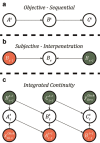Time-consciousness in computational phenomenology: a temporal analysis of active inference
- PMID: 36937108
- PMCID: PMC10022603
- DOI: 10.1093/nc/niad004
Time-consciousness in computational phenomenology: a temporal analysis of active inference
Abstract
Time plays a significant role in science and everyday life. Despite being experienced as a continuous flow, computational models of consciousness are typically restricted to a sequential temporal structure. This difference poses a serious challenge for computational phenomenology-a novel field combining phenomenology and computational modelling. By analysing the temporal structure of the active inference framework, we show that an integrated continuity of time can be achieved by merging Husserlian temporality with a sequential order of time. We also show that a Markov blanket of the present moment integrates past and future moments of both subjective temporality and objective time in an asynchronous manner. By applying the integrated continuity, it is clear that active inference makes use of both subjective temporality and objective time in an integrated fashion. We conclude that active inference, on a temporal note, qualifies as a computational model for phenomenological investigations.
Keywords: active inference; computational phenomenology; consciousness; temporal analysis; temporality.
© The Author(s) 2023. Published by Oxford University Press.
Conflict of interest statement
None declared.
Figures



Similar articles
-
Shared Protentions in Multi-Agent Active Inference.Entropy (Basel). 2024 Mar 29;26(4):303. doi: 10.3390/e26040303. Entropy (Basel). 2024. PMID: 38667857 Free PMC article.
-
The Self-Simulational Theory of temporal extension.Neurosci Conscious. 2023 Jun 19;2023(1):niad015. doi: 10.1093/nc/niad015. eCollection 2023. Neurosci Conscious. 2023. PMID: 37342236 Free PMC article.
-
Consciousness in active inference: Deep self-models, other minds, and the challenge of psychedelic-induced ego-dissolution.Neurosci Conscious. 2021 Sep 1;2021(2):niab024. doi: 10.1093/nc/niab024. eCollection 2021. Neurosci Conscious. 2021. PMID: 34484808 Free PMC article. Review.
-
Qualia as query act, the phenomenology of predictive error coding.Front Psychol. 2025 Apr 3;16:1531269. doi: 10.3389/fpsyg.2025.1531269. eCollection 2025. Front Psychol. 2025. PMID: 40248828 Free PMC article.
-
[Francisco Varela's neurophenomenology of time: temporality of consciousness explained?].Actas Esp Psiquiatr. 2013 Jul-Aug;41(4):253-62. Epub 2013 Jul 1. Actas Esp Psiquiatr. 2013. PMID: 23884617 Review. Spanish.
Cited by
-
Deep computational neurophenomenology: a methodological framework for investigating the how of experience.Neurosci Conscious. 2025 Aug 5;2025(1):niaf016. doi: 10.1093/nc/niaf016. eCollection 2025. Neurosci Conscious. 2025. PMID: 40799210 Free PMC article.
-
The temporal and embodied structure of the mineness sphere: some phenomenological ideas to frame mental health.Front Psychol. 2025 Jan 23;15:1376665. doi: 10.3389/fpsyg.2024.1376665. eCollection 2024. Front Psychol. 2025. PMID: 39916782 Free PMC article. Review.
-
Shared Protentions in Multi-Agent Active Inference.Entropy (Basel). 2024 Mar 29;26(4):303. doi: 10.3390/e26040303. Entropy (Basel). 2024. PMID: 38667857 Free PMC article.
-
How do inner screens enable imaginative experience? Applying the free-energy principle directly to the study of conscious experience.Neurosci Conscious. 2025 Apr 22;2025(1):niaf009. doi: 10.1093/nc/niaf009. eCollection 2025. Neurosci Conscious. 2025. PMID: 40265192 Free PMC article.
-
Motivation and Time: Motivational Congruence Theory's Stance.Integr Psychol Behav Sci. 2025 Aug 11;59(3):62. doi: 10.1007/s12124-025-09928-1. Integr Psychol Behav Sci. 2025. PMID: 40784998
References
-
- Alais D, Kong G, Palmer C. et al. Eye gaze direction shows a positive serial dependency. J Vis 2018;18:11. - PubMed
-
- Allé MC, d'Argembeau A, Schneider P. et al. Self-continuity across time in schizophrenia: an exploration of phenomenological and narrative continuity in the past and future. Compr Psychiatry 2016;69:53–61. - PubMed
-
- Barbour J, Koslowski T, Mercati F. Identification of a gravitational arrow of time. Phys Rev Lett 2014;113:181101. - PubMed
-
- Bergson H. In: Pogson FL (ed.), Time and Free Will: An Essay on the Immediate Data of Consciousness. Mineola, New York: Dover Publications, 2001.
LinkOut - more resources
Full Text Sources
Miscellaneous
